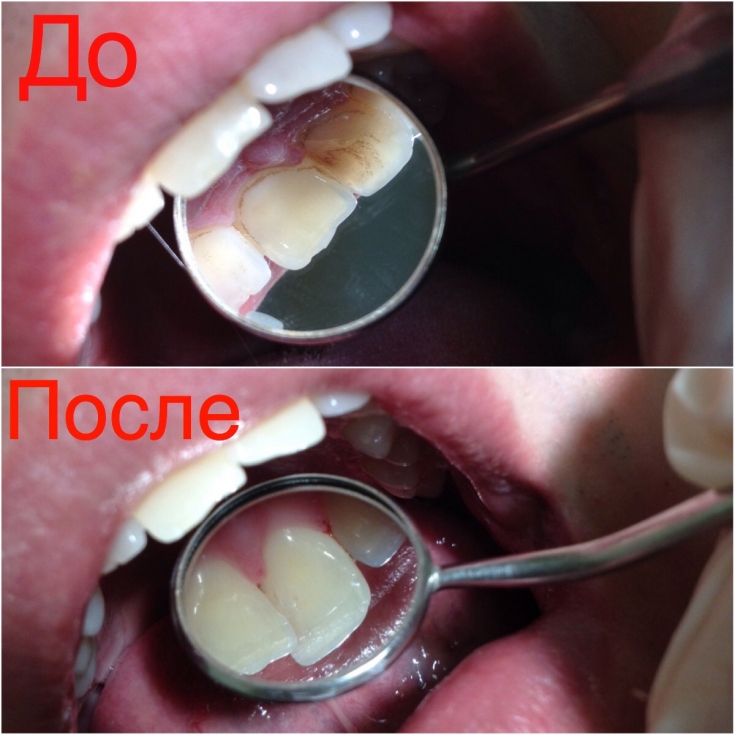Hollywood smile with white teeth – the dream of many people who care about their appearance. Fortunately, now they offer various means to achieve white teeth, but not all of them are affordable.
Air flow teeth cleaning in addition to helping to whiten teeth by 1-2 tones, it also removes top plaque and tartar. This brushing technique has other benefits as well. But is it for everyone? What are the indications and contraindications for this type of cleaning?
Today, the online edition estet-portal.com will help answer all questions about air flow.
1. Technology of air flow whitening procedure
2. Obvious benefits of air flow
3. Who should not clean air flow
Air flow whitening technology
The essence of the procedure whitening air flow is to remove plaque from hard-to-reach areas and interdental spaces, also eliminates tartar and darkening. Teeth are known to stain easily from caffeinated drinks, cigarettes, red wine.
Herself professional cleaning – exposure to plaque with a special solution of water and baking soda. Due to the abrasive agent, plaque softens and is easily removed even from hard-to-reach places.
At the same time, the particles of soda solution are small and do not damage tooth enamel, removing only pigment spots and plaque.
The air flow whitening process includes several steps:
1. goggles are put on the patient, a saliva ejector is inserted into the mouth, and lips are smeared with a moisturizer to protect them from drying out;
2. in the main stage, using an apparatus with two tips, the teeth are cleaned from plaque. From one tip a stream of air with a soda component is supplied, from the other tip – water. At a certain point, the two streams are combined and at an angle of 30-60°; directed to the dental cavity, without touching the teeth and gums. Thus, the removal of plaque is performed. The strength and power of the flow is regulated by the dentist depending on the degree of sensitivity and contamination of the teeth;
3. after cleaning with a special vacuum cleaner, the remnants of plaque are removed;
4. last step – The teeth are coated with a protective compound for a longer lasting effect.
During the air flow process, the protective organic film is removed from the teeth, so it is recommended to avoid coloring drinks and cigarettes for the first 24 hours after the procedure. After that, this film will automatically renew itself.
Follow us on Instagram.
Clear benefits of brushing with air flow
The air flow cleaning procedure has a number of advantages that are hard to ignore.
For those who doubt its merits, we emphasize:
• the procedure is absolutely harmless. Abrasive particles are small and do not harm the enamel, they only remove plaque;
• soft tissues are not damaged in any way under the action of the flow, since the doctor easily regulates the process, and the force of the flow is strictly regulated;
• the duration of the air flow procedure does not exceed 45 minutes, on average it lasts half an hour, which is much less than other types of whitening;
• cleansing of tooth enamel by 1-2 tones, returns the natural color;
• prevents caries, gingivitis. It is clearly cheaper than filling teeth later;
• after the procedure, the teeth do not suffer from hypersensitivity;
• braces, veneers, dentures are perfectly cleaned, which cannot be achieved with self-cleaning;
• when polishing, the top layer of enamel is saturated with fluorine and other useful substances;
• elimination of bad breath that occurs due to dental plaque.
The frequency of the procedure is determined by the dentist after the examination. However, airflow cleaning should not be done more than once every 3 months.
Removal of dental plaque using the air flow method is especially relevant in cases of:
• installation/removal of braces, crowns, prostheses;
• if plaque begins to transform into tartar;
• yellowing of the enamel from coffee, wine, cigarettes;
• if you need to brush your teeth well in hard-to-reach places.

Who should not have air flow
cleaned
Although the procedure is considered absolutely harmless and does not cause allergic reactions, it is still worth taking it seriously.
Before the procedure find out:
1. do you have breathing problems: asthma, chronic bronchitis;
2. Are you following a salt-free diet as the abrasive solution contains salt in the formulation;
3. if you are pregnant or breastfeeding;
4. Do you suffer from tooth sensitivity, gum inflammation.
It is also worth understanding that air flow – It's more of a professional cleaning than a specific whitening. You should not pin high hopes on the procedure in this regard: after the procedure, the natural color will return without deposits and tartar, but the teeth will not become whiter than their natural color.
Another disadvantage of the procedure is that old plaque, which has arisen from ninsufficient cleaning with a toothbrush, it does not able to remove. Only the upper food plaque and mucus with bacteria are cleaned. For deeper cleaning, it is better to have an ultrasonic cleaning session.
Brushing your teeth with air flow is not a panacea for all dental problems, however, it helps to prevent caries, periodontitis, gingivitis, periodontal disease and a number of other oral diseases.
The procedure is painless and does not take much time, so it is better to have a professional cleaning every six months than to fill your teeth afterwards.
If you choose between cleansing and whitening, please understand that these are different procedures and are not interchangeable. Depending on your wishes – prevent disease or brighten tooth enamel - you can make a choice after consulting with your doctor.
Visit the dentist at least once every six months, and you will forget about problems with your teeth.
Types of teeth whitening: is it worth using whitening varnishes
You may be interested in: Artistic Dental Restorations.






Add a comment